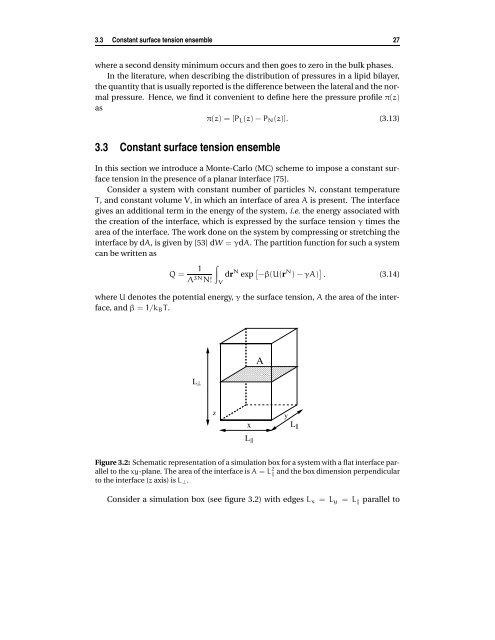Mesoscopic models of lipid bilayers and bilayers with embedded ...
Mesoscopic models of lipid bilayers and bilayers with embedded ...
Mesoscopic models of lipid bilayers and bilayers with embedded ...
You also want an ePaper? Increase the reach of your titles
YUMPU automatically turns print PDFs into web optimized ePapers that Google loves.
3.3 Constant surface tension ensemble 27<br />
where a second density minimum occurs <strong>and</strong> then goes to zero in the bulk phases.<br />
In the literature, when describing the distribution <strong>of</strong> pressures in a <strong>lipid</strong> bilayer,<br />
the quantity that is usually reported is the difference between the lateral <strong>and</strong> the normal<br />
pressure. Hence, we find it convenient to define here the pressure pr<strong>of</strong>ile π(z)<br />
as<br />
π(z) = [PL(z) − PN(z)]. (3.13)<br />
3.3 Constant surface tension ensemble<br />
In this section we introduce a Monte-Carlo (MC) scheme to impose a constant surface<br />
tension in the presence <strong>of</strong> a planar interface [75].<br />
Consider a system <strong>with</strong> constant number <strong>of</strong> particles N, constant temperature<br />
T, <strong>and</strong> constant volume V, in which an interface <strong>of</strong> area A is present. The interface<br />
gives an additional term in the energy <strong>of</strong> the system, i.e. the energy associated <strong>with</strong><br />
the creation <strong>of</strong> the interface, which is expressed by the surface tension γ times the<br />
area <strong>of</strong> the interface. The work done on the system by compressing or stretching the<br />
interface by dA, is given by [53] dW = γdA. The partition function for such a system<br />
can be written as<br />
Q =<br />
1<br />
Λ3N <br />
dr<br />
N! V<br />
N exp −β(U(r N ) − γA) . (3.14)<br />
where U denotes the potential energy, γ the surface tension, A the area <strong>of</strong> the interface,<br />
<strong>and</strong> β = 1/kBT.<br />
L⊥<br />
z<br />
¡ ¡ ¡ ¡ ¡ ¡ ¡ ¡ ¡ ¡<br />
¡ ¡ ¡ ¡ ¡ ¡ ¡ ¡ ¡ ¡<br />
x<br />
L||<br />
A<br />
y<br />
L||<br />
Figure 3.2: Schematic representation <strong>of</strong> a simulation box for a system <strong>with</strong> a flat interface parallel<br />
to the xy-plane. The area <strong>of</strong> the interface is A = L 2<br />
<strong>and</strong> the box dimension perpendicular<br />
to the interface (z axis) is L⊥.<br />
Consider a simulation box (see figure 3.2) <strong>with</strong> edges Lx = Ly = L parallel to

















